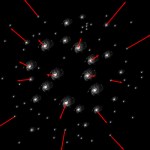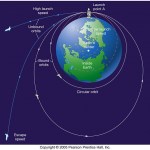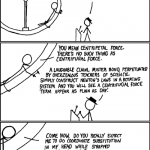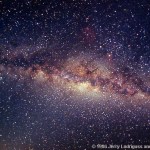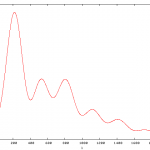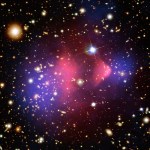
The Universe isn't a static place. Although the laws of nature (physics, chemistry, biology, etc.) don't appear to change over time, everything in the Universe appears to evolve, and changes over time. One of the simplest ways that this happens is through Hubble expansion.
General relativity tells us how the Universe expands, and more specifically, it tells us that the expansion rate (which we call the Hubble constant, H0) is related to the total energy density of the Universe. More matter density: faster expansion. Greater density of photons (i.e., light): faster expansion. More of any and…
You and I have lived on planet Earth long enough to know that if you want to launch something into space, it needs to travel fast enough to escape the pull of Earth's gravity. Launch it with too slow of a speed, and it crashes back into Earth. Launch it with a little more speed, and you can send it into orbit (like a satellite). But launch it fast enough, and it can escape from Earth's gravity altogether. The speed to completely escape from Earth's gravity is pretty fast: about 11.2 km/s, or 7 miles per second!
Make something denser and more massive, and you'll have to go faster and faster…
Apparently, this is becoming a good place for people to get their questions answered! My friend Brian, recently wanted to know what the possibilities were for faster-than-light travel. Specifically, he was interested in it because he wants humans to do it.
Brian: but otherwise how will we ever have a civilization like that in Star Trek?
Presumably, Brian's goal is to be able to travel nearly instantaneously between any two points in the galaxy. The problem is that there are physical laws we have to obey; we don't have a choice. One of them is special relativity, which tells us that the…
Last year, I had just finished my Ph.D. studies, and had moved to Madison, WI to teach introductory physics at the University of Wisconsin. I was working on this paper, and when I submitted it, I got a phone call from New Scientist magazine's space division.
Fast-forward two weeks, and I find this article online, where I got to see my name in print:
Now, scientists led by Ethan Siegel of the University of Wisconsin, in Madison, US, have come up with a new way to potentially reveal blobs of dark matter drifting nearby and perhaps even pin down what it is once and for all.
And I thought to…
One of the worst teaching tools physicists use (and they almost all do it) is to tell students,
There's no such thing as centrifugal force.
What can you do when the top physics education website says, "It is important to note that the centrifugal force does not actually exist. We feel it, because we are in a non-inertial coordinate system." There's a very funny comic over at xkcd that goes as follows:
Well, what's the deal? What really goes on, physically, and what causes a centrifuge to work? Is your physics teacher right, or is there more to the story than "the centrifugal force does not…
Okay, so I got a question from my friend Tamara, who's a high school teacher in my hometown of New York City. It concerns a recent article she read on the front page of the New York Times about something funny that us scientists are calling Boltzmann Brains.
I've read this article three times since it was featured on the front page of the science section in the NYT and I'm still confused about the Boltzmann brain problem, it's (non?)validity, the reason it made it's way onto the front page and whether Emerson's philosophy about imagined worlds came from this...
There's a lot of interesting…
I got a great question earlier today from my buddy Zrinka, and decided to figure out the answer for her, and also for myself. She asks:
Ethan, is it possible to know, or better to say to imagine somehow how our galaxy looks from outside?
What a simple-sounding question! After all, we know what the Earth looks like from the outside: we just go outside of it and photograph it. But the galaxy is too big to do that to; it would take tens of thousands of years moving at the speed of light to get that far away! So we're left with the option of looking at our galaxy from inside of it, and trying to…
Evolution, creationism, and intelligent design are words that many people have extremely strong opinions about. Regardless of how you feel about why the laws of nature are what they are, which have evidently allowed us to exist, the evidence for the validity of the theory of evolution with one major mechanism being natural selection is absolutely overwhelming. That said, this is often very hard to communicate to people, especially those with strong biases against what they perceive as the implications of evolution, how evolution works, and why the case for it is so compelling.
Thankfully,…
One of the perks of being a postdoc at a place like the University of Arizona, one of the top places in the US for astronomy, is that we get a number of really interesting visitors. Today we got paid a visit by Tommaso Treu, an astronomer at UC Santa Barbara.
He spoke to us today about one of his most recent, most interesting discoveries, done with the Hubble Space Telescope, of a double Einstein Ring. Take a look at the image below:
You'll notice that there's a ball of light in the center with some ring-like structure(s) around it. These things are rare, first off. There are only two ways…
The first serious advocate of modifying Newton's laws instead of postulating unseen (or dark) matter was Moti Milgrom, from whom today a new article appears on the astrophysics preprint archives.
In particular, Milgrom asserts the following:
MOND predictions imply that baryons alone accurately determine the full field of each and every individual galactic object. These predictions are contrary to the expectations in the DM paradigm in view of the following:
a. the haphazard formation and evolution of galactic objects,
b. the very different influences that baryons and DM are subject to during…
Dave, one of my online chessplaying buddies, asked me this question (edited for appropriateness):
Now this speeding up of the expansion of the universe: Do I understand correctly that one of the theories to explain why relates to "dark matter"?
In real simple terms, what in the dark blue blazes is dark matter, and why and how (and I think the "how" is what keeps you boys up late at night) does it cause this increase in speed?
So Dave gives me the opportunity to, first off, make the distinction between dark matter and dark energy.
Dark matter is, quite simply, matter that doesn't emit…
Taking a look at the background picture, and wondering what it is? It's the Bullet Cluster, also known to astronomers as 1E 0657-56.
What's so special about it? Well, these are actually two galaxy clusters that are in the process of merging, and are colliding with one another! Although this is very cool (and rare) in and of itself, finding this object allowed us to test experimentally the dark matter hypothesis.
If all of the matter in the universe was composed of protons, neutrons, and electrons, then we would find mass in the same place we find light. But look at the x-ray…
In preparation for the launch of startswithabang.com, I am attempting to embed a video I had found on youtube, of the slow-motion ignition of a lighter.
How does this work? The video demonstrates that to make something very simple happen (to get a sustained, controlled flame out of a compact piece of equipment), a lot of thought needs to go into how it's made, and what each step is going to accomplish. A lighter works by the following:
Flint and steel rub together (that's turning the wheel) to create very high temperatures along the metal shavings, which fly off in many…
